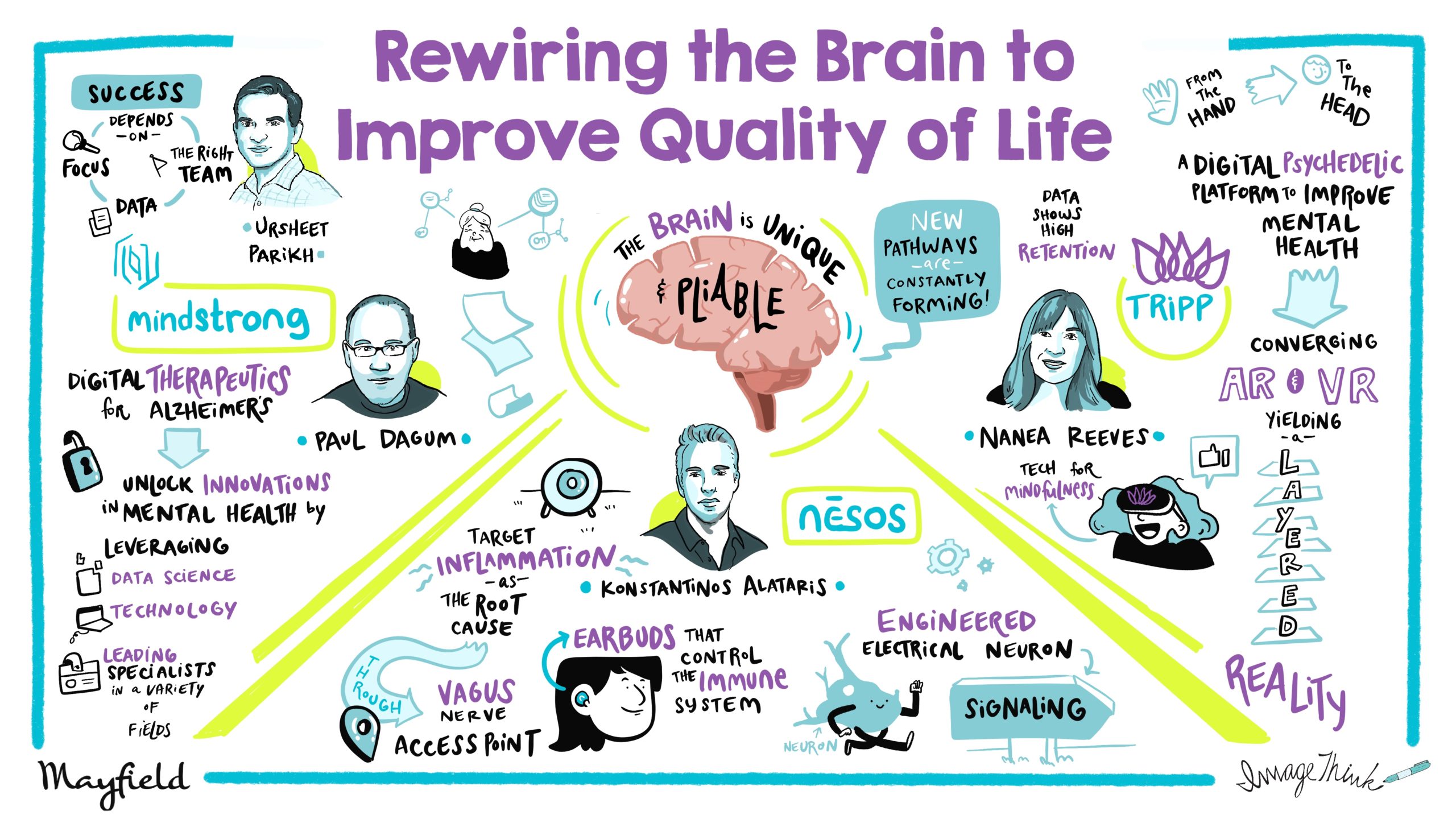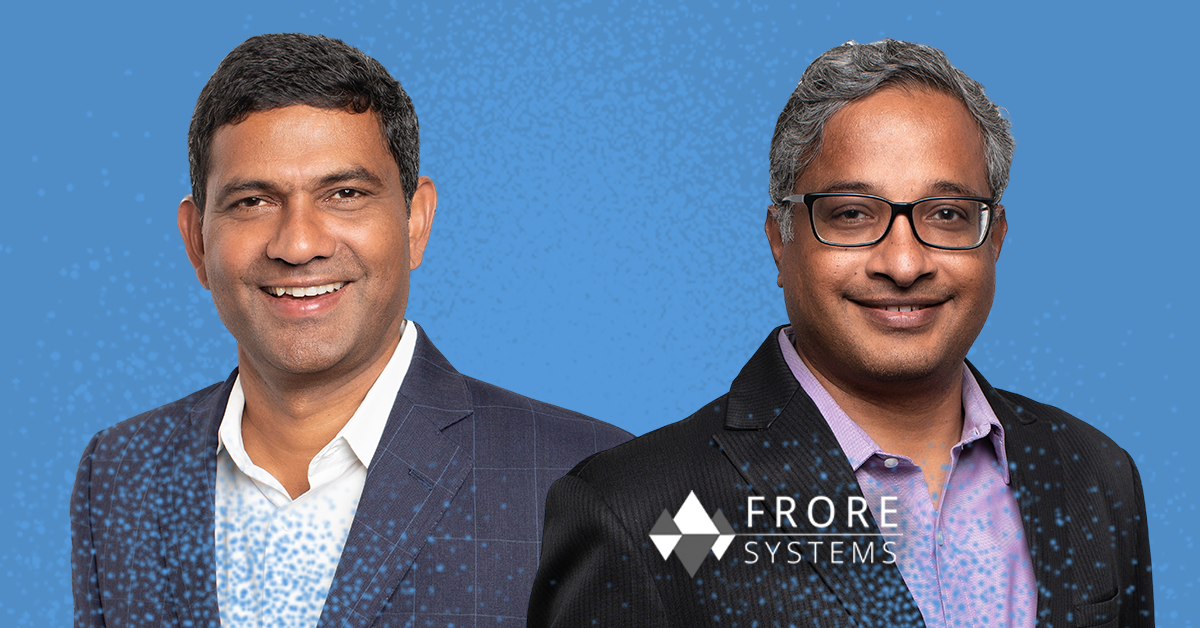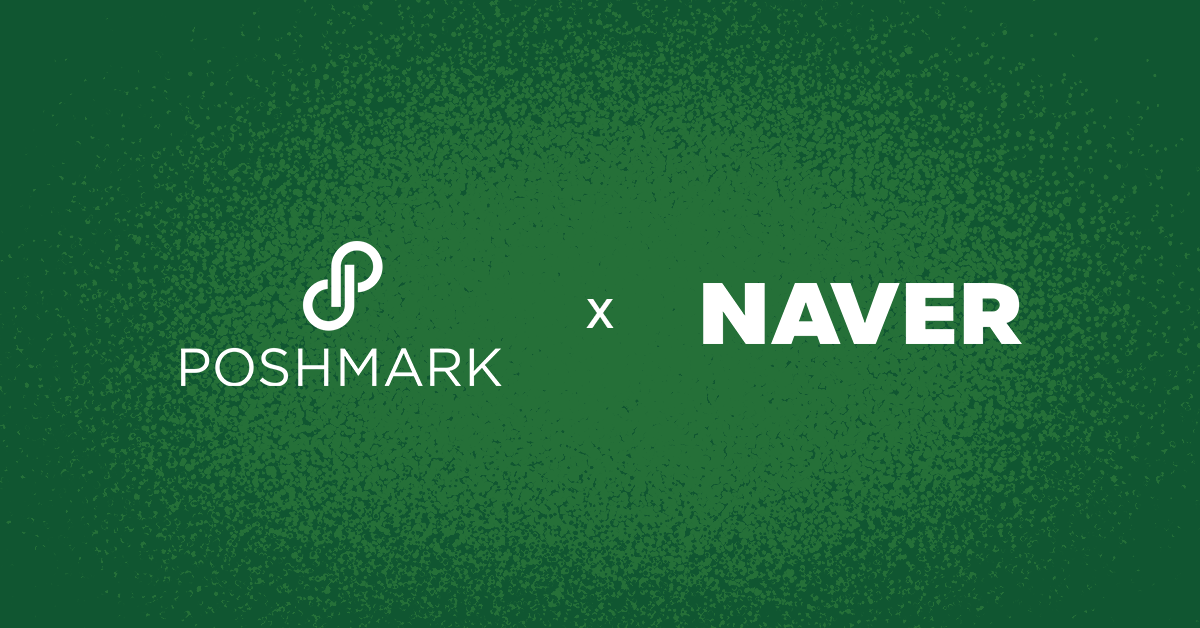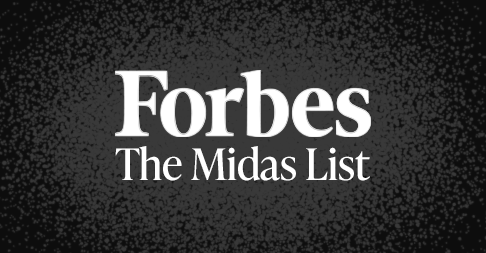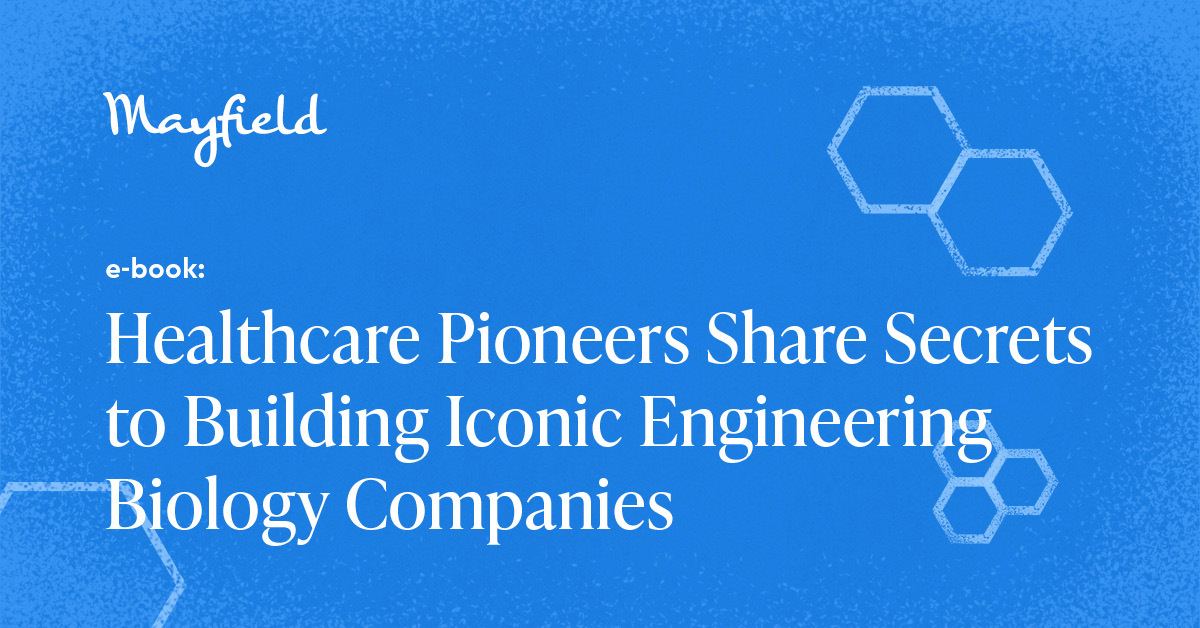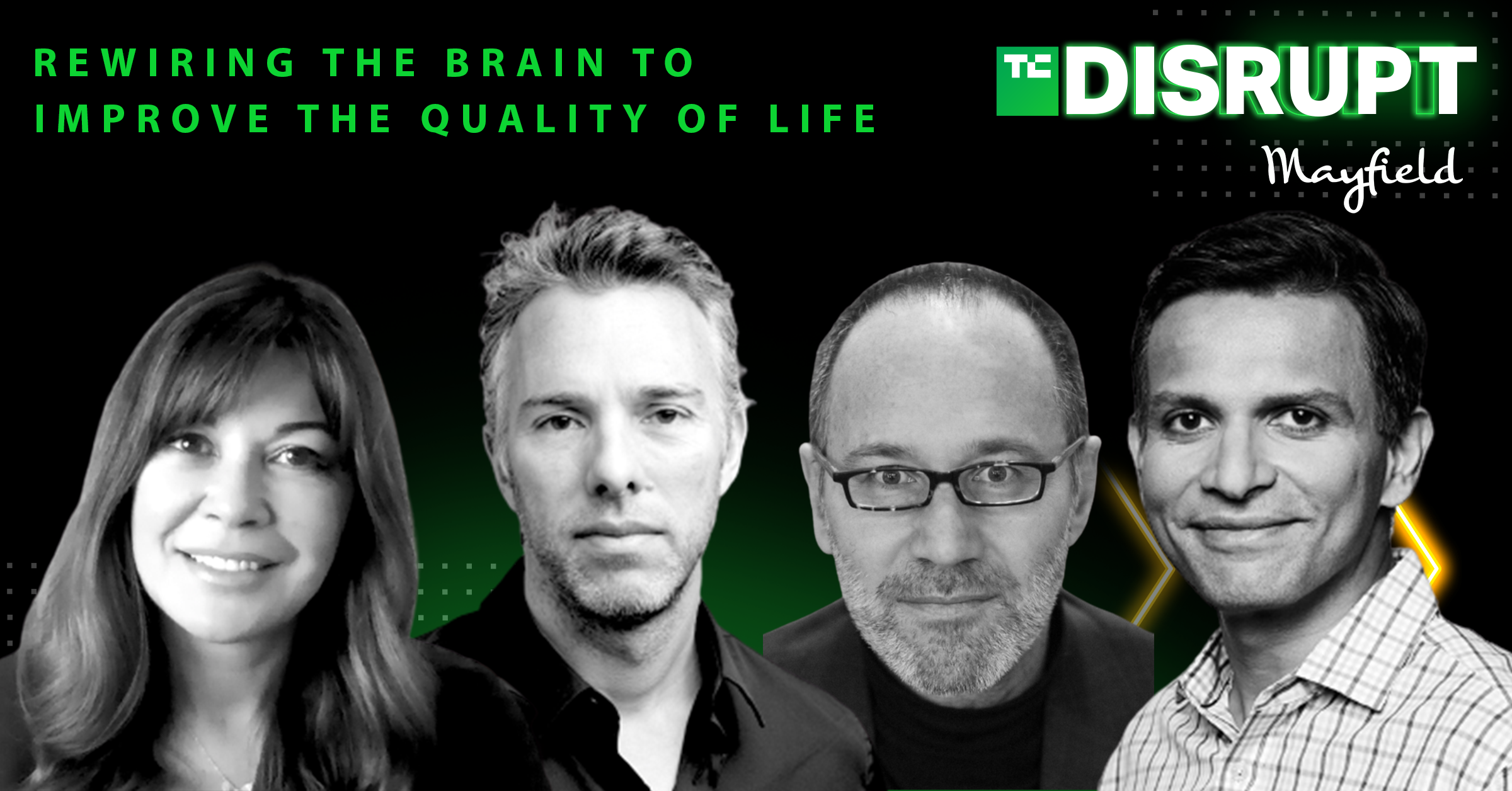TRIPP is a digital psychedelic platform that fully immerses you into alternate realities to improve your mental and emotional well-being. Nēsos’ purpose-built earbuds retrain neural pathways to control inflammation, creating the new category of e-mmunotherapeutics. Mindstrong is transforming mental health through innovations in virtual care, data measurement, and data science. The brain is in a state of constant evolution, responding to new electrical signals from the senses and nerves. Hear from these neuroscientists, physicians, and entrepreneurs about how to build brain-based businesses that improve the quality of life.
Transcript
Ursheet Parikh:
What we are going to talk about next is really more mind-bending than my favorite movie Inception. I’ve always been fascinated with the brain, but at the same time just frustrated by how slow new treatments for our physical and mental health that involve the brain have been in coming to market. It’s not uncommon for new treatments to take 10 years only to find that they don’t work and cost several hundred million dollars. We think that part of it is because the brain is just a very unique organ. It’s different between animals and humans, so a lot of the traditional sort of drug development pathways don’t work. It’s also designed to keep drugs out of the brain, but at the same time, it’s very, very pliable and constantly forms new connections based on what we see, what we think, what we hear consciously as well as subconsciously.
And so we thought that it’s time there was a new way, so we started thinking about rewiring the brain. And at Mayfield, we believe in partnering with pioneers. None of them are bolder than the ones who are going to be on this panel, who are rewiring the brain to make our lives better. It sounds like science fiction, but this is all very real. And we’ll look to our panelists to convince us what they’re doing is real here and now. And so with that, it’s with delight and pleasure that I get to introduce this amazing panel of serial entrepreneurs. One is a former gaming executive, one is a neuroscientist, one is a physician, and they’re all building breakthrough businesses that involve working with the human brain.
First off, we have Nanea Reeves. She is the founder and CEO of TRIPP. She’s also a former gaming exec and she’s building a digital psychedelic platform that exposes us to alternate realities for improving mental and emotional wellbeing. We also have Konstantinos Alataris. Konstantinos is an entrepreneur that has actually built one of the biggest successes in the human computer interface world. He did a company called Nevro, which is a spinal cord stimulator to alleviate pain. It’s a $5 billion company, and he’s on doing his next company Nēsos. Nēsos is purpose-built earbuds that actually connect your brain to activate it and get it to control your immune system. It’s a new class of therapeutics called e-muunotherapeutics and we are excited to hear about what he has to say and where they’re going.
And then finally, we have Paul Dagum. Paul’s the former CEO and founder of Mindstrong Health, which is transforming mental health with virtual care data measurement and data science. And he’s onto his next company called Applied Cognition, and that’s addressing disease conditions in neurodegeneration, like Alzheimer’s. So Nanea, Paul, Konstantinos welcome. Glad to have you all with me today. Paul, let’s start with you. What is your vision for Applied Cognition?
Paul Dagum:
Thank you for having me on your panel, Ursheet. Today we have 47 million Americans who have preclinical Alzheimer’s disease. Those numbers are growing, and many of them will progress to cognitive impairment or dementia. Our mission is to develop the first FDA approved digital therapeutic for Alzheimer’s disease.
Ursheet Parikh:
And how is this going to get delivered?
Paul Dagum:
How far have we gone in our vision? We’ve assembled an amazing team of micro technology engineers, material scientists, product and industrial designers, mechanical engineers, software engineers, clinical scientists and Alzheimer’s neurologists. They each come from iconic institutions, have achieved tremendous individual distinction in their respective fields, and they share our passion for our mission. Where we’re at in terms of development, we are using and leveraging advances in microtechnology, in material science and AI to develop sensors that can measure the neuropathology of Alzheimer’s disease in an unobtrusive and continuous way.
Ursheet Parikh:
That’s pretty amazing. As you were talking about sort of the type of team members that you have, it’s amazing that so many different disciplines are coming together to take on what has become the big… While we are in COVID and there’s one pandemic, they’re dealing with the long term epidemic around mental health. So delighted to see you out on this journey. Nanea, what is your mission and inspiration for TRIPP?
Nanea Reeves:
Well, I think the thing we’re most excited about at TRIPP is really believing in the future of computing moving from the hand to the head and being the next gen wellness application for that transition. We’re very much committed as a team to create heart-centered experiences that help people transform the way that they feel, but we work very closely with academia and medical in the neuroscience community to make sure that we’re measuring and validating all of our design choices. And it’s a very cool experience, it sits somewhere in between mindfulness, producing the effects of mindfulness and psychedelics, and we deliver through VR and AR currently.
Ursheet Parikh:
Yeah. I’ve seen that it’s featured as one of the top applications on Oculus.
Nanea Reeves:
Yeah.
Ursheet Parikh:
What are the other platforms besides Oculus?
Nanea Reeves:
We’re also on PlayStation VR. So that gives us the largest audience in XR wellness to date. And we very recently launched on the Nreal glasses, our first wave of augmented reality experiences. So we think of it less vertically about VR versus AR, really there’s a convergence into one device that we’ll see over time. It’s really, for us, about how do we innovate around reality layering and do that all within this wrapper of creating beneficial experiences. And it’s kind of a narrative violation to use tech for making you feel better, but we really find that that mission is really exciting, not only to the end user but also to attract really great talent who want to use their skills to make a difference in the world.
Ursheet Parikh:
Yeah. I know, a lot of the smartest people of my generation have spent their life creating digital addicts, selling digital dope.
Nanea Reeves:
Yep. Yep.
Ursheet Parikh:
So I’m sure a lot of my friends are excited about the prospect.
Nanea Reeves:
Yeah. And you think about using AI in ways that we have in the past to manipulate you to feel so badly about yourself that you’ll buy something to fix you. Can we kind of reframe that in ways that make you feel good?
Ursheet Parikh:
Great. Konstantinos, you’ve had an amazing history even before starting Nēsos, but what inspired you to start Nēsos and what does Nēsos do?
Konstantinos Alataris:
So for us, a starting point, frankly, was the role of inflammation – understanding more research around chronic underlying inflammation as one of the root causes in many diseases, from mental health, neuropsychiatric, neurological and autoimmune disorders. The other part of this equation was the fact that there is a lot more research and understanding. First of all, understanding that the brain and the immune system are in communication and interaction, constant interaction, with something that kind of recent in the last 20-30 years, we kind of understand more. And there is masonry through which the brain, not only senses, but can control inflammation levels mainly through the autonomic side of the brain.
So that, for us, those two elements and previous work that we’ve done that allows us to start interfacing with the autonomic part of the nervous system give us the idea that maybe now we can target this pathway that controls inflammation through engineered neural signaling. So that’s kind of what we’re trying to do and right now the best way to prove it is going to the clinic. So we have three programs in the clinic that span neuropsychiatric to autoimmune diseases.
Ursheet Parikh:
Konstantinos, that’s great. I’d love to get into exploring – how do we know this stuff is real? But can you just elaborate a little bit more on how the product works? Do I kind of inject myself, do I get operated on to put something in my head? What made it possible for you to sort of go from that category of products that you did 10 years ago to this new category of products?
Konstantinos Alataris:
Yeah, a little bit, the anatomical solution was that there is a branch of the vagus nerve, which is a big part of the autonomic nervous system, that actually is external, outside of your ear. So we have an access point. So for us, the access point is on the outer ear and the way we’re accessing or delivering the therapy, which is engineered nerve signals, is through an earbud. So that’s what makes it a kind of a form that people are familiar with and easy to use. So these are earbuds that you need to place in your ear for a few minutes a day. And through that, we’re trying to intervene into that masonry and retrain it to control it as it used to, because we know in the disease progression, it stops controlling it as well as it used to.
Ursheet Parikh:
Just mind blowing, right? No pun intended that you actually put a new kind of airpod and you don’t listen to any music through it, but it kind of goes and tells your brain to activate the immune system to fight disease. This does sound like science fiction. So how do we know this thing is working? Why should people believe this stuff is real?
Konstantinos Alataris:
Well the clinical data, which is from one study, we’ve published in the Lancet, the rheumatology edition, and there are more publications coming up. There is quite a lot of research from many academic institutions and researchers that have published the data that have shown the connection, not only the ability of that pathway to relate information to the brain about inflammatory levels, but also the other way from the brain to send instructions to the spline in order to modulate pro inflammatory cytokines. So that pathway has been very well enumerated, right now we’re trying to see how well we can restore that pathway. And there are other approaches with more invasive tools. For us, given that we have this access point, we plan to fully explore that among different indications. So that’s how we came here.
Ursheet Parikh:
That’s great. Yeah. I’ve seen your paper that was published in Lancet, which is unlike a lot of the other journals like Nature and Science. All the doctors I know do read Lancet and the fact that the success of your first trial was covered in that and now you’re running randomized control trials. So the net of what I’m taking is that you’re going to say, “We’re going to let the data do the talking.” And it won’t be on just surveys, it’ll actually be on diseases, like rheumatoid arthritis, where you actually have objective endpoints that you can see in x-ray to show that it kind of works out on that end.
Konstantinos Alataris:
For us, just because of the diseases that we’re trying to treat, there’s very well defined endpoints. So the data has to talk and develop the credibility around this therapeutic approach. I think that’s the best rather than pointing to preclinical work, which is relevant at the beginning. Now we’re in the clinic, as you said, we are doing randomized placebo control studies.
Ursheet Parikh:
Yeah, so Nanea, Konstantinos is actually going with a pure therapeutic label and so he’s going to go do the trials and then prove it and then kind of get the claims. You have dipped in the market available to consumers as we speak. How are you demonstrating the effects and the benefits of TRIPP?
Nanea Reeves:
Well, we don’t currently make any claims on efficacy, especially with the consumer product. We think there’s a lot that can be done to support people in the subclinical dimension with our wellness offering. But what we have found is that the body of data being produced by our service, we collect survey data in app with every session. And now because we have a significant audience producing over two and a half million sessions, that data actually has become very meaningful to researchers, et cetera. It’s enough data to train AI as well. So in addition, though, we have throughout the years, and it does move at a much slower pace than my startup motor, we’ve stood up some clinical trials. We have received funding from the national institutes of health, specifically, NIDA, for use in addiction recovery. We are now approved to move into phase two on that research.
We have some exciting RCTs up and running with the New York Office of Mental Health and other entities analyzing our product and the effect on their population. So eventually we could start to target more focused interventions for different in indications, but right now we see that the data itself that our services producing has really helped just harden our engagement in a way that a lot of the other clinically focused XR companies aren’t able to do at the scale that we have. We have excellent retention. And when you look at even the attrition rate in clinical trials and XR wellness, especially in mental health apps, we’re blowing doors off that data currently with our largest monthly cohort using TRIPP four months or longer. And so for any kind of intervention, if you don’t have adherence and especially in a digital therapeutic, I think it is going to be a commercial failure after years of development.
Ursheet Parikh:
Yeah. I think you touched upon two very key points. One is you want to have these products and that these products have to engage. But the second is that these are sort of connected products and you get a closed loop view and the data actually helps make the treatments better over time.
Nanea Reeves:
Correct.
Ursheet Parikh:
And so that kind of accelerates the pace at which new products can kind of be created. Paul, what would you like to tell the audience who say this is sounding like science fiction? How do you sort of convince them?
Paul Dagum:
Yeah, I think what I would say to the audience is, I think we all are aware of, there’s a tremendous amount of research in Alzheimer’s and we’re really tapping into amazing work being done by scientists and clinicians around the planet. One of the things that we’ve learned recently in the last few years is the interplay between neurophysiology, cerebral vasculature and neurovascular that you’re coupling and the importance of that house and the neuropathology of Alzheimer’s. So what we’re doing is we’re tapping into that mechanism and we’re instrumenting it and hoping to be able to measure target engagement of our therapeutic interventions. I think a lot, like what we heard from Konstantinos, our journey is a regulatory pathway so we have to be very scientific and evidence based. And the bar is the FDA at the end of the day for us. So that’s what I would share with the audience.
Ursheet Parikh:
Yeah. It’s great that while these things can kind of be made to work in a certain way that you guys are putting this level of sort of rigor in development, because for a whole new class of acclaim that is so groundbreaking, that level of rigor is going to be key to adoption. I think we’re going to be out of time soon. And so I want to move to a lightning round. All of you are immensely successful, I believe no success is accidental. And so, what would be the one learning that you have from your journey so far that you’d like to tell our audience, right? Nanea, do you want to go first?
Nanea Reeves:
Sure. I think really coming from a sense of purpose will help you really stay narrowly focused on surviving as a startup, especially in the face of opposition. It really keeps me going to know that I really do feel mission driven and I think anything is hard to do, especially from the ground up. So if you don’t have that connection, it’s going to make it infinitely much more difficult to succeed.
Ursheet Parikh:
Yeah, no, that’s that’s well said. Paul.
Paul Dagum:
Yeah. I would share that from my experience going from science to product takes a lot longer than you think. And so I would encourage young entrepreneurs to find patient investors.
Ursheet Parikh:
Thanks. Konstantinos.
Nanea Reeves:
Like Ursheet.
Konstantinos Alataris:
Well, for me, it’s always coming from a culture that talks about the journey, but the journey is about the people that you go with. I do believe that the people that come with you, the team, has even importance as far as making the right steps to discover what’s in front of you. So although I went alone, you shouldn’t go alone and the people that are with you determine your success. That’s my lesson.
Ursheet Parikh:
Well, that’s very well said. At Mayfield we’ve had this strong people-first philosophy and it goes back to our founder, Tommy Davis, who started Mayfield in 1969. He famously said, “People make products. Products don’t make people.” And so I think mission, purpose, patience, people, are all hard learned lessons, but as relevant as they’ve always been. I could go on for hours with you guys, right, I mean, there’s just so much that I think you guys have to offer and so much fun we could have talking about more stuff. But I think we are out of time and thank you, Nanea, Paul, Konstantinos for making this happen and thank you TechCrunch for hosting us.
